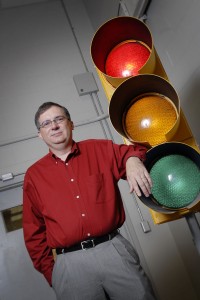
TUSCALOOSA, Ala. — For many, holidays are not only associated with spending time with friends and families, but they also are a time of traveling. With more people on the road traveling to see their friends and families, crashes are inevitable.
A recent University of Alabama study shows that the days preceding and following holidays, rather than the holidays themselves, are at a high risk for serious crashes involving injuries or fatalities. These results come from UA’s Center for Advanced Public Safety’s recent study of 2008 Alabama crashes involving injuries or fatalities.
Typically, a holiday has a low serious-crash number because most people have already reached their destinations and tend to remain there. For this reason, Thanksgiving Day in 2008 was the 13th lowest day of the year for serious crashes.
With a reduction in gas prices, more people are driving long distances, rather than flying. This is one explanation as to why the number of serious crashes surrounding Thanksgiving were high on the Friday preceding Thanksgiving and on the weekend following the holiday.
The Friday immediately after Thanksgiving has several risk factors for crashes. Known as “Black Friday,” it is one of the busiest shopping days of the year. Also, many people begin leaving their Thanksgiving celebrations and returning home. On average, Fridays have 25 percent more serious crashes than other days of the week.
“There are definitely times to be avoided, especially if bad weather is a possibility,” said Dr. Allen Parrish, professor of computer science and director of CAPS at The University of Alabama.
Parrish noted some typical problem days that would be wise to avoid, including the two days following Thanksgiving and the Wednesday before Thanksgiving, especially late in the day. Christmas Eve and the nighttime hours of New Year’s Eve and New Years Day are also high risk times that would be wise to avoid.
Much like the Thanksgiving holiday, the days surrounding Christmas are more dangerous than Christmas Day. In 2008, Christmas Day had only 33 serious crashes, one of the lowest numbers for the year. However, Christmas Eve had 100 crashes, making it one of the days with the most serious crashes. People often hurrying to get last-minute presents on Christmas Eve may account for the higher crash number.
Alcohol consumption also typically increases around the holidays and is another added risk factor. While New Year’s Eve is always a night to be cautious because of the higher number of people drinking, in 2008 the number of serious crashes actually fell below average with 69 on New Year’s Eve and only 40 on New Year’s Day.
“We credit this to the programs that are launched during the holidays to encourage designated drivers and the heavy enforcement efforts that have proven effective in getting the DUI drivers off the road,” said Parrish.
The largest exception to the pattern of serious crashes falling on the days surrounding the holiday, rather than the holiday itself, in 2008 was Halloween, which was the 13th highest day for crashes. Halloween was on a Friday, and there were more people on the streets for Halloween festivities.
“The basic problem is not just the volume of vehicles, it is also the mix of drivers,” explained Parrish. “The situation obviously gets more dangerous when there is a large concentration of people on the road who are not nearly as familiar with their routes as commuters.”
Parrish also offered some key safety recommendations for driving during the holidays:
- Do not drive while intoxicated, do not ride with others who are intoxicated, and avoid the obvious times and places where you might become the victim of drunken driving;
- Always wear your seat belt, regardless of how long the trip;
- Keep children properly restrained in the back seat;
- Keep the speed down. Most speed limits provide guidance to the extent that control can be maintained and damage will not result in a fatality if the speed limit is observed;
- Watch the weather reports, and plan your trip accordingly; and
- Be acquainted with traffic problem areas and avoid them.
“Driving does not have to be dangerous,” said Parrish. “If you keep these safety basics in mind, you will cut your chances of being killed in a car crash to a very low probability.”
UA’s Center for Advanced Public Safety, part of the computer science department, uses leading-edge technologies to offer products and specialized software development services in a variety of areas, particularly traffic safety and law enforcement. CAPS used their own CARE software to analyze the Alabama 2008 crash data to obtain the statistics for this article. Additionally, CAPS routinely provides a variety of safety studies and planning documents, such as the Crash Facts Books and Highway Safety Plans.
In 1837, The University of Alabama became one of the first five universities in the nation to offer engineering classes. Today, UA’s fully accredited College of Engineering has more than 2,700 students and more than 100 faculty. In the last eight years, students in the College have been named USA Today All-USA College Academic Team members, Goldwater scholars, Hollings scholars and Portz scholars.
Contact
Mary Wymer, engineering public relations, 205/348-6444, mwymer@eng.ua.edu